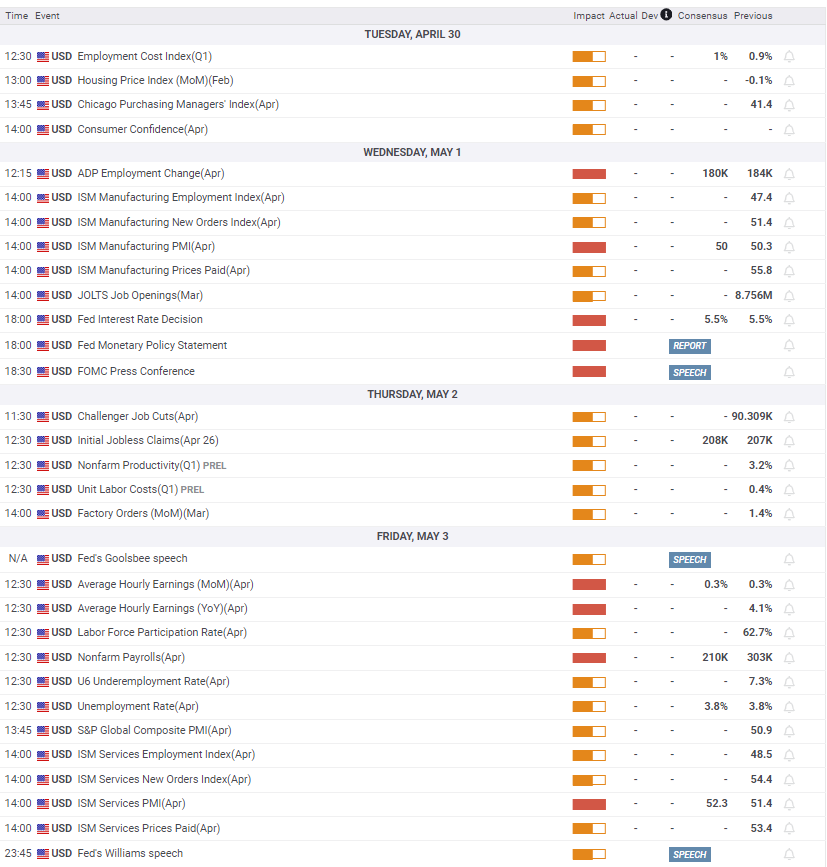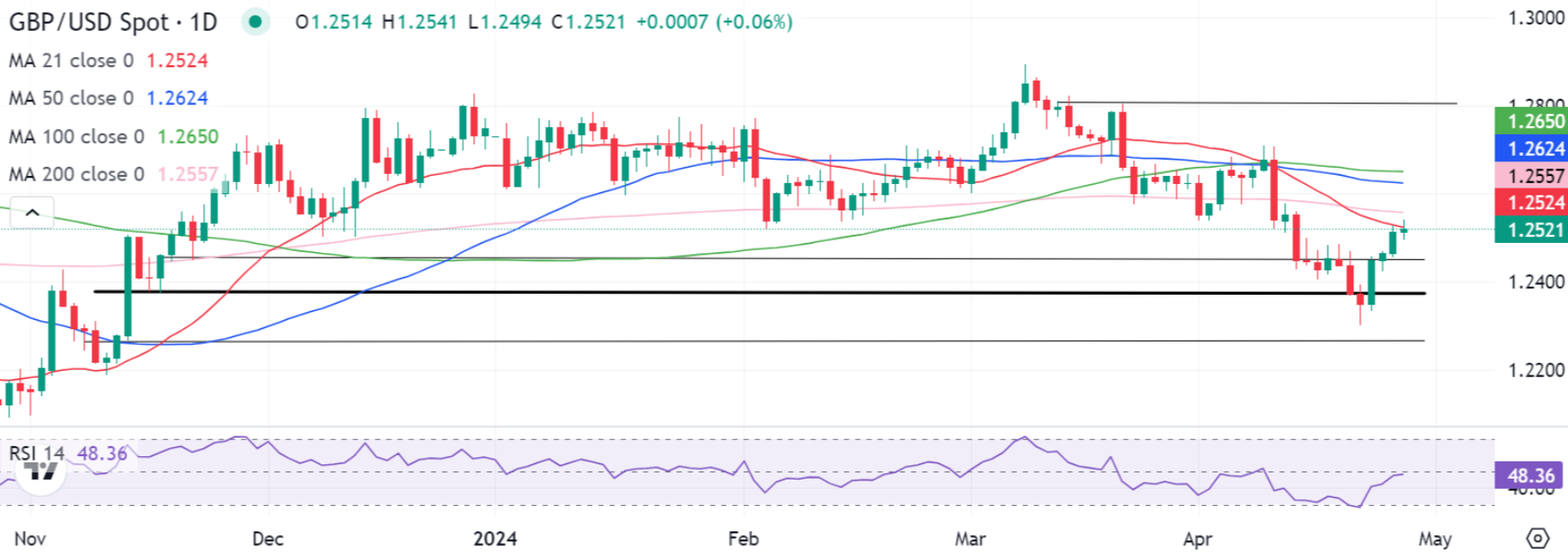- The Pound Sterling rebounded from five-month lows at 1.2300 against the US Dollar.
- The GBP/USD upturn is unlikely to last as the Fed rate decision and US Nonfarm Payrolls loom.
- The Pound Sterling needs acceptance above 1.2555 to sustain the recovery.
- The daily RSI still lurks below 50.00, warranting caution for GBP/USD buyers.
The Pound Sterling (GBP) rebounded firmly against the US Dollar (USD), with the GBP/USD pair snapping two weekly declines in a row.
Pound Sterling rebounds, but not out of the woods yet
Pound Sterling witnessed a negative start to the week despite the return of risk appetite on ebbing fears over a wider regional conflict in the Middle East. No official comments from Israel confirming Friday’s Israeli missiles strike on Iran and denial of further retaliatory measures by Iranian authorities calmed markets down.
It looked like the British Pound suffered from the dovish commentary delivered on Friday by Bank of England (BoE) Deputy Governor Dave Ramsden, who said that risks to persistence in domestic inflation pressures were receding, suggesting that a BoE policy pivot is inevitable later this year.
Thereafter, the tide turned in favor of the GBP/USD pair, allowing it to stage a solid comeback from a new five-month low of 1.2300. The retreat in the US Dollar from multi-month highs against its major currency counterparts was the main reason behind the pair’s turnaround.
Weak US macro data cast doubts on the country’s economic resilience, contributing to the US Dollar correction. S&P Global said on Tuesday that its preliminary US Composite PMI Output Index, which tracks the manufacturing and services sectors, fell to 50.9 in April from 52.1 in March. Both Manufacturing and Services PMI fell short of market expectations in April. Further, the US economy slowed in the first quarter, growing at an annualized rate of 1.6%, against expectations of a 2.5% expansion in the reported period.
Despite the discouraging economic performance, markets continued to price in the first US Federal Reserve (Fed) interest-rate cut in September, according to the CME Group’s FedWatch Tool. Meanwhile, the total easing expected this year would just be 40 basis points (bps), a sea change from about the 150 basis points of cuts priced in at the beginning of the year, per Reuters.
Sustained bets for a delayed Fed policy pivot lent support to the Greenback, but the upbeat US tech earnings-led risk environment also helped the higher-yielding Pound Sterling. Additionally, improving UK business activity in April aided the GBP/USD recovery. The S&P Global UK Composite Purchasing Managers' Index for the services and manufacturing sectors jumped to an 11-month high of 54.0 in April from March's 52.8.
On Friday, the data from the US showed that the core Personal Consumption Expenditures (PCE) Price Index rose 2.8% on a yearly basis in March. This reading came in above the market expectation of 2.6% and helped the USD hold its ground. In turn, GBP/USD struggled to build on its weekly gains heading into the weekend.
What to watch for in the Federal Reserve week
After a data-busy week in the United States, traders keenly await another eventful week, with the Fed policy decision likely to stand out.
The UK economic docket is once again relatively quiet data-wise, and therefore, the sentiment around the Fed rate expectations and the US Dollar price action will continue to drive the GBP/USD pair.
Monday is devoid of any top-tier data releases from both sides of the Atlantic. The focus, thus, shifts toward Tuesday’s quarterly release of the US Employment Cost Index for Q1 and the Conference Board Consumer Confidence data for April. China’s official Manufacturing and Non-Manufacturing PMI data will be also reported early Tuesday, which could have a reasonable impact on risk sentiment, eventually influencing the demand for the safe-haven US Dollar.
The economic calendar is busiest on Wednesday even though it’s a European market holiday. The US docket features the ADP Employment Change data, followed by the ISM Manufacturing PMI and JOLTS Job Openings data. However, the main event risk that day remains in the Fed interest rate decision and Chairman Jerome Powell’s press conference.
The US events are expected to spike the volatility around the US Dollar, impacting the currency pair.
On Thursday, traders will brace for another busy US calendar, filled with mid-tier data flow, including the weekly Jobless Claims, Preliminary Unit Labor Costs Index and Factory Orders data.
Finally, the US Nonfarm Payrolls data will hog the limelight on Friday. The ISM Services PMI and its sub-indices will be also closely-watched by market participants.
GBP/USD: Technical Outlook
Having bounced off from the key 1.2300 round level, GBP/USD ripped through several key supports, now turned resistances, to challenge the critical 200-day Simple Moving Average (SMA) at 1.2557.
A weekly closing above the 200-day SMA is required to build on the recovery momentum in the week ahead.
The main cause of concern for buyers, however, is that the 14-day Relative Strength Index (RSI) still lurks below the 50 level.
If Pound Sterling buyers face rejection at the abovementioned 200-day SMA of 1.2557, a retracement toward the initial support of the November 16 and 17 lows confluence at near 1.2375 will be retested.
A sustained move below the latter will expose the downside toward the November 14 low at 1.2266. Ahead of that, the five-month low of 1.2300 could rescue buyers.
On the flip side, a meaningful upside toward the 1.2630-1.2650 supply zone cannot be ruled out if the 200-day SMA is taken out decisively. That area is where the 50-day and 100-day SMAs hang around.
The next topside hurdle is seen at around the 1.2800 threshold.
Pound Sterling FAQs
The Pound Sterling (GBP) is the oldest currency in the world (886 AD) and the official currency of the United Kingdom. It is the fourth most traded unit for foreign exchange (FX) in the world, accounting for 12% of all transactions, averaging $630 billion a day, according to 2022 data. Its key trading pairs are GBP/USD, aka ‘Cable’, which accounts for 11% of FX, GBP/JPY, or the ‘Dragon’ as it is known by traders (3%), and EUR/GBP (2%). The Pound Sterling is issued by the Bank of England (BoE).
The single most important factor influencing the value of the Pound Sterling is monetary policy decided by the Bank of England. The BoE bases its decisions on whether it has achieved its primary goal of “price stability” – a steady inflation rate of around 2%. Its primary tool for achieving this is the adjustment of interest rates. When inflation is too high, the BoE will try to rein it in by raising interest rates, making it more expensive for people and businesses to access credit. This is generally positive for GBP, as higher interest rates make the UK a more attractive place for global investors to park their money. When inflation falls too low it is a sign economic growth is slowing. In this scenario, the BoE will consider lowering interest rates to cheapen credit so businesses will borrow more to invest in growth-generating projects.
Data releases gauge the health of the economy and can impact the value of the Pound Sterling. Indicators such as GDP, Manufacturing and Services PMIs, and employment can all influence the direction of the GBP. A strong economy is good for Sterling. Not only does it attract more foreign investment but it may encourage the BoE to put up interest rates, which will directly strengthen GBP. Otherwise, if economic data is weak, the Pound Sterling is likely to fall.
Another significant data release for the Pound Sterling is the Trade Balance. This indicator measures the difference between what a country earns from its exports and what it spends on imports over a given period. If a country produces highly sought-after exports, its currency will benefit purely from the extra demand created from foreign buyers seeking to purchase these goods. Therefore, a positive net Trade Balance strengthens a currency and vice versa for a negative balance.
Information on these pages contains forward-looking statements that involve risks and uncertainties. Markets and instruments profiled on this page are for informational purposes only and should not in any way come across as a recommendation to buy or sell in these assets. You should do your own thorough research before making any investment decisions. FXStreet does not in any way guarantee that this information is free from mistakes, errors, or material misstatements. It also does not guarantee that this information is of a timely nature. Investing in Open Markets involves a great deal of risk, including the loss of all or a portion of your investment, as well as emotional distress. All risks, losses and costs associated with investing, including total loss of principal, are your responsibility. The views and opinions expressed in this article are those of the authors and do not necessarily reflect the official policy or position of FXStreet nor its advertisers. The author will not be held responsible for information that is found at the end of links posted on this page.
If not otherwise explicitly mentioned in the body of the article, at the time of writing, the author has no position in any stock mentioned in this article and no business relationship with any company mentioned. The author has not received compensation for writing this article, other than from FXStreet.
FXStreet and the author do not provide personalized recommendations. The author makes no representations as to the accuracy, completeness, or suitability of this information. FXStreet and the author will not be liable for any errors, omissions or any losses, injuries or damages arising from this information and its display or use. Errors and omissions excepted.
The author and FXStreet are not registered investment advisors and nothing in this article is intended to be investment advice.
Recommended Content
Editors’ Picks

EUR/USD trims losses and approaches 1.1380
The US Dollar now succumbs to the re-emergence of the selling pressure and allows EUR/USD to recoup part of the ground lost and approach to the 1.1380 zone on Thursday. Earlier on Thursday, the ECB matched estimates and lowered its rates by 25 bps.

GBP/USD extends the daily recovery, looks at 1.3300
The upside impulse in the British pound remains everything but abated and now propels GBP/USD to the upper end of the range, shifting its attention to recent yearly peaks near 1.3300 the figure.

Gold breaks below $3,300, daily troughs
Further improvement in the sentiment surrounding the risk-associated universe put Gold prices to the test on Thursday. Indeed, the troy ounce of the precious metal faces increasing downside pressure and breaches the key $3,300 mark to hit new daily lows.

Crypto market cap fell more than 18% in Q1, wiping out $633.5 billion after Trump’s inauguration top
CoinGecko’s Q1 Crypto Industry Report highlights that the total crypto market capitalization fell by 18.6% in the first quarter, wiping out $633.5 billion after topping on January 18, just a couple of days ahead of US President Donald Trump’s inauguration.

Future-proofing portfolios: A playbook for tariff and recession risks
It does seem like we will be talking tariffs for a while. And if tariffs stay — in some shape or form — even after negotiations, we’ll likely be talking about recession too. Higher input costs, persistent inflation, and tighter monetary policy are already weighing on global growth.

The Best brokers to trade EUR/USD
SPONSORED Discover the top brokers for trading EUR/USD in 2025. Our list features brokers with competitive spreads, fast execution, and powerful platforms. Whether you're a beginner or an expert, find the right partner to navigate the dynamic Forex market.

